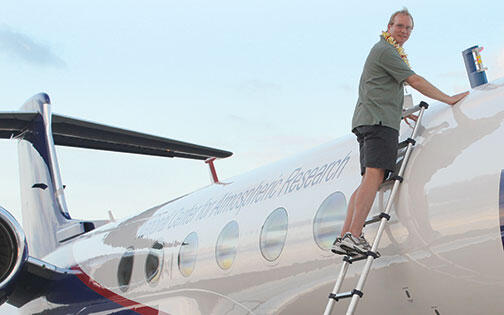Engineering: Aloft, Zondlo Tracks Greenhouse Gases
Where clouds are born Those long, wispy strands high in the sky you can see on a clear day are cirrus clouds. Typically present at 30,000 to 40,000 feet even when lower clouds cover them, cirrus clouds are made of water vapor. Scientists don’t know the exact conditions needed for cloud formation, but understanding the process could clarify how human activity, especially pollution, is contributing to climate change.
It’s all in the details Mark Zondlo, an assistant professor of civil and environmental engineering, takes to the skies to measure water vapor, which is the most abundant greenhouse gas. Water vapor has a large impact on the climate: When global temperatures rise, more water vapor is present, which traps more heat in the air and makes temperatures go up. During eight-hour excursions on a former corporate jet — transformed into a flying research laboratory by the National Science Foundation — Zondlo uses a laser-based sensor he developed to track water vapor and its impact on clouds. Zondlo’s research team has logged more than 1,000 hours of flight time using the sensor, which can detect minor fluctuations in water vapor. The data so far show that cirrus clouds form when relative humidity is above 100 percent, and that where they form is strongly dependent on local changes in water vapor.
New tools to understand the atmosphere Zondlo uses similar laser-based optical sensors to detect air pollutants and other greenhouse gases. His work is part of Princeton’s Mid-InfraRed Technologies for Health and the Environment, an engineering research center with multi-million-dollar funding from the federal government to develop sensors that detect minute amounts of chemicals found in the atmosphere. The sensors developed in Zondlo’s laboratory are low-power and mobile — easily mountable on a car, a small drone, or an airplane — and can take measurements 10 times a second. The output is a chemical fingerprint that can identify the source region and the specific gases in real time.
Global yet local Zondlo and his team hit the road to study how air quality influences climate. With a sensor mounted on the ski rack on their car, they recently took road trips in California, Texas, and Beijing. “We found that the amount of ammonia emitted from cars is much higher than expected from prior measurements,” says Zondlo. Ammonia is difficult to measure but is an important contributor to the unhealthy haze over polluted cities such as Beijing. “We want to develop effective mitigation strategies for climate change,” Zondlo says.













No responses yet